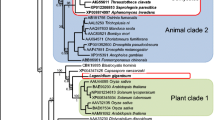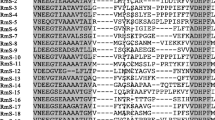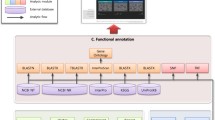Abstract
The expressed sequence tags (ESTs) of Angiostrongylus cantonensis were analyzed in an attempt to gain further insight into its genomic expression patterns. A total of 1,277 ESTs of A. cantonensis were randomly downloaded from NCBI databank. ESTs were analyzed and annotated using Blastx. The result showed that there were 60 ESTs had no match to any of the proteins and gene sequences in the published databases, and 695 ESTs score more than 80. According to the function, the identified 695 ESTs could be grouped into 13 categories related to metabolism, cellular development, immune evasion, host–parasite interactions, and so on. Among them, 65 (9.4%) were proteases and protease inhibitors, represented 19 potential proteases and protease inhibitors genes; 42 (6.0%) were allergens or antigens, represented 15 potential antigens/allergens genes. SignalP analysis was applied to the 19 putative proteases and protease inhibitors and the 15 antigens/allergens protein sequences to identify the potential signal peptides and anchors. The result demonstrated that there were ten putative proteins had N-terminal signal peptides and three had signal anchors, these putative excretory/secretory proteins might be the products of potential parasitism genes which played an important role in the adaptation of A. cantonensis to a parasitism life. These parasitism genes and proteins identified are expected to become potential targets for future research on anti-A. cantonensis drugs; moreover, the resulting genetic information is useful in elucidating the mechanisms of parasitism of A. cantonensis.
Similar content being viewed by others
References
Aldape K, Huizinga H, Bouvier J, McKerrow J (1994) Naegleria fowleri: characterization of a secreted histolytic cysteine protease. Exp Parasitol 78:230–241
Baum TJ, Hussey RS, Davis EL (2007) Root-knot and cyst nematode parasitism genes: the molecular basis of plant parasitism. Genet Eng 28:17–43
Blaxter M, Daub J, Guiliano D, Parkinson J, Whitton C (2002) The Brugia malayi genome project: expressed sequence tags and gene discovery. Trans Royal Soc Trop Med Hyg 96:7–17
Cui LW, Fan Q, Hua Y, Karamycheva SA, Quackenbush J, Khuntirat B, Sattabongkot J, Carlton JM (2005) Gene discovery in Plasmodium vivax through sequencing of ESTs from mixed blood stages. Mol Biochem Parasitol 144:1–9
Dalton JP, Neill SO, Stack C, Collins P, Walshe A, Sekiya M, Doyle S, Mulcahy G, Hoyle D, Khaznadji E, Moiré N, Brennan G, Mousley A, Kreshchenko N, Maule AG, Donnelly SM (2003) Fasciola hepatica cathepsin 1-like proteases: biology, function, and potential in the development of first generation liver fluke vaccines. Int J Parasitol 33:1173–1181
de Vries E, Corton C, Harris B, Cornelissen A, Berriman M (2006) Expressed sequence tag (EST) analysis of the erythrocytic stages of Babesia bovis. Vet Parasitol 138:61–74
Fragoso RR, Lourenço IT, Batista JAN, Oliveira-Neto OB, Silva MCM, Rocha TL, Coutinho MV, Grossi-de-Sa MF (2009) Meloidogyne incognita: Molecular cloning and characterization of a cDNA encoding a cathepsin D-like aspartic proteinase. Exp Parasitol 121:115–123
Guiliano DB, Hong XQ, McKerrowc JH, Blaxter ML, Oksov Y, Liu J, Ghedin E, Lustigman S (2004) A gene family of cathepsin L-like proteases of filarial nematodes are associated with larval molting and cuticle and eggshell remodeling. Mol Biochem Parasitol 136:227–242
Harcus YM, Parkinson J, Fernández C, Daub J, Selkirk ME, Blaxter ML, Maizels RM (2004) Signal sequence analysis of expressed sequence tags from the nematode Nippostrongylus brasiliensis and the evolution of secreted proteins in parasites. Genome Biol 5:R39.1–R39.15
Hou RF, Tu WC, Lee HH, Chen KM, Chou HL, Lai SC (2004) Elevation of plasminogen activators in cerebrospinal fluid of mice with eosinophilic meningitis caused by Angiostrongylus cantonensis. Int J Parasitol 34:1355–1364
Klee EW, Ellis LB (2005) Evaluating eukaryotic secreted protein prediction. BMC Bioinformatics 6:256–262
Loukas A, Jones MK, King LT, Brindley PJ, McManus DP (2001) Receptor for Fc on the surface of schistosomes. Infect Immun 69:3646–3651
Morales ME, Rinald G, Gobert GN, Kines KJ, Tort JF, Brindley PJ (2008) RNA interference of Schistosoma mansoni cathepsin D, the apical enzyme of the hemoglobin proteolysis cascade. Mol Biochem Parasitol 157:160–168
Pérez-Pérez J, Fernández-Caldas E, Marañón F, Sastre J, Bernal ML, Rodríguez J, Bedate CA (2000) Molecular cloning of paramyosin, a new allergen of Anisakis simplex. Int Arch Allergy Immunol 123:120–129
Putney SD, Herlihy WC, Schimmel P (1983) A new troponin T and cDNA clones for 13 different muscle proteins, found by shotgun sequencing. Nature 302:718–721
Richer JK, Hunt WG, Sakanari JA, Grieve RB (1993) Dirofilaria immitis: effect of fluoromethyl ketone cysteine protease inhibitors on the third- to fourth-stage molt. Exp Parasitol 76:221–231
Sharma R, Azam A, Bhattacharya S, Bhattacharya A (1999) Identification of novel genes of non-pathogenic Entamoeba dispar by expressed sequence tag analysis. Mol Biochem Parasitol 99:279–285
Siles-Lucas M, Nunes CP, Zaha A, Breijo M (2000) The 14-3-3 protein is secreted by the adult worm of Echinococcus granulosus. Parasite Immunol 22:521–528
Siles-Lucas M, Merli M, Mackenstedt U, Gottstein B (2003) The Echinococcus multilocularis 14-3-3 protein protects mice against primary but not secondary alveolar echinococcosis. Vaccine 21:431–439
Tetteh KK, Loukas A, Tripp C, Maizels RM (1999) Identification of abundantly expressed novel and conserved genes from the infective larval stage of Toxocara canis by an expressed sequence tag strategy. Infect Immun 67:4771–4779
Thompson FJ, Mitreva M, Barker GL, Martin J, Waterston RH, McCarter JP, Viney ME (2005) An expressed sequence tag analysis of the life-cycle of the parasitic nematode Strongyloides ratti. Mol Biochem Parasitol 142:32–46
Wang YC, Ma H, Liu GF, Zhang DW, Ban QY, Zhang GD, Xu CX, Yang CP (2008) Generation and analysis of expressed sequence tags from a NaHCO3-treated Limonium bicolor cDNA library. Plant Physiol Bioch 46:977–986
Wang XZ, Gobert GN, Feng XG, Fu ZQ, Jin YM, Peng JB, Lin JJ (2009) Analysis of early hepatic stage schistosomula gene expression by subtractive expressed sequence tags library. Mol Biochem Parasitol 166:62–69
Wippersteg V, Kapp K, Kunz W, Grevelding CG (2002) Characterisation of the cysteine protease ER60 in transgenic Schistosoma mansoni larvae. Int J Parasitol 32:1219–1224
Yu HS, Park SK, Lee KH, Lee SJ, Choi SH, Ock MS, Jeong HJ (2007) Anisakis simplex: analysis of expressed sequence tags (ESTs) of third-stage larva. Exp Parasitol 117:51–56
Yuan J, Shaham S, Ledoux S, Ellis HM, Horvitz HR (1993) The C. elegans cell death gene ced-3 encodes a protein similar to mammalian interleukin-1-β-converting enzyme. Cell 75:641–652
Zang X, Yazdanbakhsh M, Jiang H, Kanost MR, Maizels RM (1999) A novel serpin expressed by blood-borne microfilariae of the parasitic nematode Brugia malayi inhibits human neutrophil serine proteinases. Blood 94:1418–1428
Zhao QP, Moon SU, Na BK, Kimd SH, Cho SH, Lee HW, Kong Y, Sohn WM, Jiang MS, Kim TS (2007) Paragonimus westermani: biochemical and immunological characterizations of paramyosin. Exp Parasitol 115:9–18
Acknowledgments
The project was supported by Science and Technology Planning Project of Fujian Province (Grant No. 2008N2005), China.
Author information
Authors and Affiliations
Corresponding authors
Electronic supplementary material
Below is the link to the electronic supplementary material.
Table 1
Blastx output for the ESTs of Angiostrongylus cantonensis. (DOC 1346 kb)
Rights and permissions
About this article
Cite this article
Fang, W., Xu, S., Wang, Y. et al. ES proteins analysis of Angiostrongylus cantonensis: products of the potential parasitism genes?. Parasitol Res 106, 1027–1032 (2010). https://doi.org/10.1007/s00436-010-1751-z
Received:
Accepted:
Published:
Issue Date:
DOI: https://doi.org/10.1007/s00436-010-1751-z




